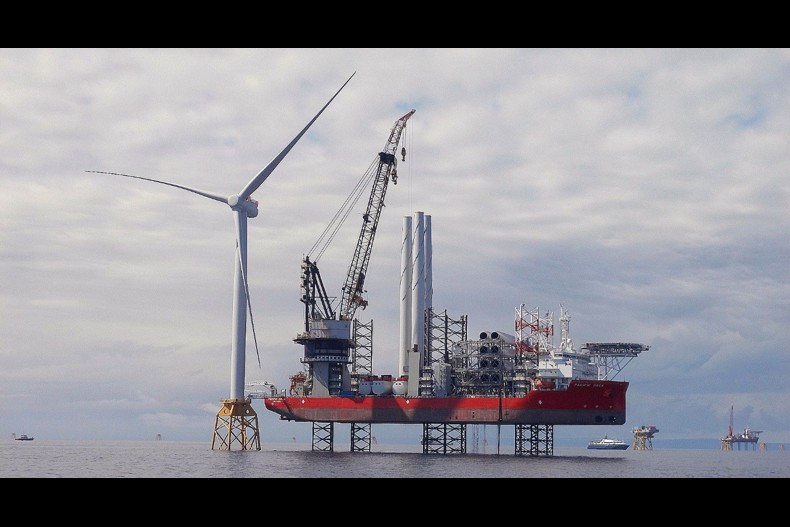
This article originally appeared as an op-ed by SSE Ireland Managing Director Stephen Wheeler in the Irish Independent on 21 January 2019.
There was a time when Ireland was the undisputed leader in offshore wind energy. Just over 15 years ago, the world’s largest offshore wind farm was to be found in the Irish Sea.
Turbine manufacturer GE Energy and renewable energy developer Airtricity co-developed a seven-turbine offshore wind farm off the Wicklow coastline. Generating 25MW of green energy, Arklow Bank Phase 1 was designed to prove the capability of offshore wind, not only in Irish waters but globally.
Opened by Taoiseach Bertie Ahern with much fanfare, there were broad political hints that funding support for offshore wind energy would be forthcoming for future projects around our island.
Well, that was then – and the policy promises of over a decade ago never materialised. As we enter 2019, the seven Arklow turbines remain the first and only operational offshore wind farm in Ireland.
Where Ireland was a leader in renewable energy 15 years ago, we are now internationally recognised as the worst performing European state on climate action. Our carbon-emitting sins are many. And we’re one of the few EU countries where carbon emissions continue to climb.
Onshore wind energy has been a huge success story here in Ireland. But the scale and urgency of the challenge we face is now greater than ever. We can no longer solely depend on onshore energy to meet our climate and energy targets. And we need to look beyond our 2020 targets – which we will miss – to targets for 2030 and out to 2050.
We need a new renewables revolution, and that revolution needs to be offshore where oceans of opportunity lie.
Ireland’s potential for offshore wind is enormous. Our seabed territory is one of the largest in Europe, more than ten times the size of our land mass. And we have an incredible wind resource off our entire coastline.
We already have a number of significant projects in Irish waters, at different stages of development, which can deliver around 4.5 GW of offshore energy in the coming years. At SSE, we’re actively progressing our plans to develop the next phase of Arklow Bank Wind Park, which can deliver a minimum of 520 MW of capacity. That’s enough energy from one offshore wind site to power around half a million homes or five new 50MW data centres.
The industry is poised to invest billions of euro in large capital expenditure to develop Ireland’s offshore wind energy assets to their full potential. However, policy and technical barriers continue to hold back the development of our largest renewable resource.
The new Renewable Electricity Support Scheme (RESS) launched by Government last summer to replace REFIT provides only an ‘indicative outline’ of how offshore wind energy may be treated in future auctions. In the detail, the potential size of individual auctions open to offshore energy appear too small to allow large-scale projects to commercially progress.
For this reason, industry continues to encourage Government to implement a category of sufficient scale for offshore wind in the final RESS design. This will send the early signals needed to give greater certainty to developers and investors, as well as to enable a new Irish job-creating supply chain to be ready for when offshore wind projects are scheduled to be delivered.
Additionally, we need action on grid. We continue to exist in a limbo where no grid connection policy is in place that provides access to the market for offshore.
These policy and technical barriers can be overcome if the political will is there to make it happen.
So, it was important to see the Government publish its first draft National Energy and Climate Plan just before Christmas. This plan sets a target to hit at least 55% renewable electricity by 2030. More heartening still was to hear the comments of our new Climate Action Minister Richard Bruton who, in launching the plan, said Ireland will back a diversified energy system that is likely to include offshore wind in addition to other technologies.
These are important step-change policy statements. And for once, you begin to feel that there is a real political urgency and a sense of commitment to stepping up and becoming a leader, once again, in responding to climate change.
And if we want an example of what a step-change looks like, then look no further than our nearest neighbour. In the 15 years in which Ireland’s offshore sector has been stalled, the UK set clear and ambitious policies that delivered 7GW of installed capacity. Today, the UK is the global leader in offshore wind and almost 10% of Britain’s power needs come from offshore wind. By 2030, it is planned that offshore wind will deliver at least a third of the UK’s electricity supply and, in doing so, will create tens of thousands of new supply chain jobs.
We need to take inspiration from that approach, and devise similar strategies for Ireland to ensure offshore wind is harnessed to power Ireland’s homes, businesses and economy. In doing so, we will ensure Ireland is a leader once again in tackling climate change, and playing our rightful role in promoting climate justice. Let’s make 2019 the year in which we make that change.
Stephen Wheeler is Managing Director of SSE Ireland, the country’s largest renewable energy developer and generator.


